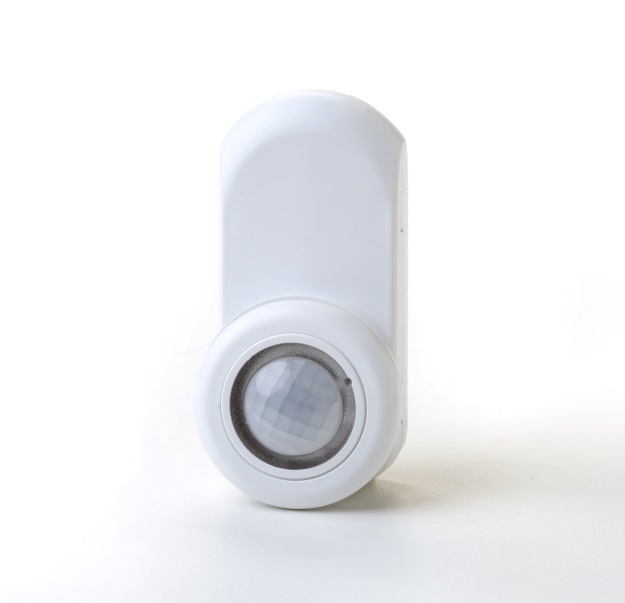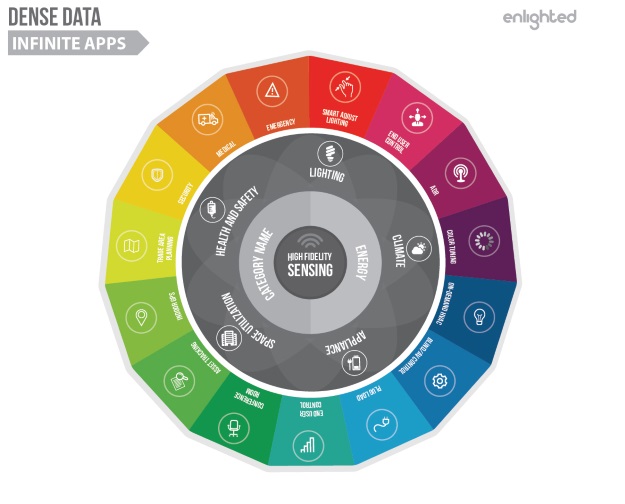BY ZACH GENTRY,
VP Business Development,
Enlighted,
www.enlightedinc.com
Thanks to smart sensors and networked lighting systems, the Internet of Things (IoT) and big data have become viable for commercial buildings. The commercial building industry is no longer in the beta testing and data stage when it comes to collecting and analyzing big data. Market-proven systems and approaches are available today for collecting digital data, analyzing it on the back end and empowering commercial building owners with the ability to act. And benefits are significant.
Before diving into the IoT and big data for commercial buildings, it is important to understand the technology making all this possible. Networked lighting systems – a combination of lighting, advanced digital sensors, smart controls and data analytics – can provide information about what is happening in a building at any point in time.
For example, smart sensors (see Fig. 1 ) can detect natural daylight so lighting can be dimmed in relevant spaces to reduce energy use. But lighting is only the beginning. Intelligent, networked systems are collecting all types of data from motion to temperature and energy use. Additionally, these systems have the ability to connect and communicate with other building systems – such as HVAC, demand response systems, security, safety, and other space management applications.

Fig. 1: Smart sensor detects natural lighting and dims lighting to reduce energy use
The secret to collecting and interpreting big data is highly advanced sensors and the right architecture. Advanced, digital sensors can track temperature, light levels, daylight, motion, heat and energy use. Furthermore, these smart sensors can accurately distinguish people from other non-human heat sources and motion – such as fax machines, space heaters or boxes on a conveyer belt.
The architecture is important to achieve the most granular data possible. This can be accomplished by deploying a sensor in each and every light fixture to provide a high-level data stream, delivering a holistic picture of the building.
The rich data collected can then be used to save energy, utilize space more effectively and provide a better working environment in a variety of building management areas, including lighting, HVAC, space utilization, and safety and security.
Lighting
Advanced sensors can provide valuable information on the most efficient approach for lighting a space. Facility managers are able to gather key insights, including what areas of the building are naturally lit during the day to which areas are being over lit.
Occupancy and vacancy sensors determine when a space is being utilized, so lighting can be adjusted accordingly. Facility managers can determine the best lighting schedule based on when occupants are most frequently in the space or building.
Daylight harvesting is also important in managing energy savings during daylight hours. Special sensors detect the amount of natural sunlight coming in from the windows and adjust artificial light levels accordingly.

Fig. 2: Occupancy and vacancy sensors determine when a space is being utilized, so lighting can be adjusted accordingly
Task tuning adjusts light levels for the task at hand, which helps make the space more comfortable for employees while also helping support energy savings. For example, an employee working on a manufacturing line might need more light than an employee working on a computer. This element of personalization can support an increase in employee productivity, and also help secure additional LEED points.
Space utilization
The advanced sensors can also track occupancy motion, providing building owners, facility managers, architects and contractors valuable insight into how spaces are used or not used. So much is possible now from identifying traffic patterns in a space to creating heat maps of motion, motion trails, tracking when employees arrive and leave and more.
A very simple application of this data is if a conference room is not being used building managers can allocate the space for another use. Retailers can use the motion trail information to track aisle traffic or how moving product effects traffic patterns. This data is available real-time down to the second or can be viewed over time to identify trends.
The data becomes even more useful for large campuses or buildings in a variety of cities and states. Headquarter staff now has access to data about all their facilities at their fingertips. They can help support the local offices more effectively by expanding when needed or identifying opportunities to better utilize space.
HVAC
Temperature and occupancy/vacancy sensors can provide data to better optimize HVAC. Temperature monitoring can identify hot and cold spots to help facility managers identify areas being over or under heated/cooled. Furthermore, occupancy and vacancy sensors can help identify spaces not being used frequently so heating or cooling can be adjusted accordingly.
Temperature and occupancy/vacancy data not only can increase energy savings, but also occupant comfort. Increasing employee comfort can lead to increased productivity, potentially increasing the bottom line.
Safety and security
Data from smart sensors can be used to support the overall safety and security of a building and building occupants. Smart sensors can monitor where occupants are in a building at any time, providing essential information regarding any intruders, disaster recovery and business planning.
Applications of occupancy monitoring to increase safety and security includes dim-and-linger occupancy and sequential and pathway lighting control. Dim-and-linger occupancy control warns occupants prior to lights being turned off. Furthermore, they enable users to override the control system prior to the lights turning off. Sequential and pathway lighting controls also provide additional safety and security by anticipating and illuminating the pathway in front of pedestrians, customers and employees.
Meaningful data = meaningful results
With the right technology, data collected from smart sensors provides building owners, facility managers, architects, engineers, lighting designers and more information about what is happening in a space at any point in time. This intelligence and connectivity among key building systems – lighting, HVAC, safety and security, and space planning – can enable an entirely new set of monitoring, control, optimization and autonomy.

Fig. 3: With the right technology, data collected from smart sensors provides information about what is happening in a building space at any point in time.
However, data alone is not the answer. The data needs to be presented in a way to building owners, managers and contractors so it is actionable. This is where desktop, tablet and mobile apps come into play, providing any easy way to read, assess and interpret the data.
System integration is also key, allowing the lighting, HVAC, safety and security systems to automatically utilize the data to achieve better energy efficiency, occupant comfort and safety and security.
Advertisement





